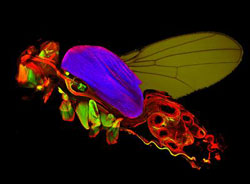Fruit Flies – A Model for Bodybuilders

A genetic program is responsible for the development of different muscle cells in the fruit fly. Picture: Frank Schnorrer / Copyright: MPI of Biochemistry <br>
Together with colleagues from the Research Institute of Molecular Pathology (IMP) in Vienna, Austria, scientists of the Max Planck Institute (MPI) of Biochemistry in Martinsried near Munich, Germany, have now succeeded in identifying all genes of the fruit fly Drosophila that play a role in the development and function of muscles. “It is fascinating how the genetic programme of an organism is able to produce such different cell types out of identical precursor cells,” says Frank Schnorrer, group leader at the MPI of Biochemistry. The work has now been published in Nature.
The human body consists of ten to hundred trillion cells. And not all the cells are identical: The human body consists of 200 different cell and tissue types. Each one of these cell types experiences a special genetic program during its development. At the end of such a development red blood cells transport oxygen, nerve cells pulse signals and muscle cells generate mechanical force.
In cooperation with Barry Dickson's Lab at the Research Institute of Molecular Pathology (IMP) in Vienna, Max Planck scientists of the research group “Muscle Dynamics”, headed by Frank Schnorrer, have now systematically analyzed all 12,000 genes of the fruit fly for their role in muscle development and function. Like humans, fruit flies have different types of muscles: some let larvae crawl slowly, others let the wings of adult flies flap as quickly as a flash.
By performing more than 25,000 flight tests, the scientists identified about 2,000 genes that have a function in fly muscles. “Some genes are needed in all the muscles,” explains Frank Schnorrer, “others only in the very fast and strong flight muscles.” The flight muscles of flies belong to the strongest muscles in the animal kingdom. “They are able to produce 100 watt per kilogram muscle mass and that over a long period of time,” says the biochemist. “Bodybuilders and Tour de France riders can only dream about such a performance. They steadily manage about 30 watt per kilogram muscle mass.”
Many of the identified genes exist in humans as well and are supposedly also needed for normal human muscle function. A change in these genes often leads to muscle diseases. For instance, mutations in the Laminin genes are responsible for a particular form of degenerative muscle disease, muscular dystrophy. “In the future, insight into such connections may help to detect and treat muscle diseases individually,” hopes Frank Schnorrer.
Original Publication:
F. Schnorrer, C. Schönbauer, C. C. H. Langer, G. Dietzl, M. Novatchkova, K. Schernhuber, M. Fellner, A. Azaryan, M. Radolf, A. Stark, K. Keleman and B. J. Dickson: Systematic genetic analysis of muscle morphogenesis and function in Drosophila. Nature, March 11, 2010
Contact:
Dr. Frank Schnorrer
Muscle Dynamics
Max Planck Institute of Biochemistry
Am Klopferspitz 18
82152 Martinsried
schnorrer@biochem.mpg.de
Anja Konschak
Public Relations
Max Planck Institute of Biochemistry
Am Klopferspitz 18
82152 Martinsried
Phone ++49/89-8578-2824
E-mail: konschak@biochem.mpg.de
www.biochem.mpg.de
Dr. Heidemarie Hurtl
Communications
Research Institute of Molecular Pathology
Dr. Bohr Gasse 7
A-1030 Wien
Tel. ++43 1 79730 3625
hurtl@imp.ac.at
Media Contact
All latest news from the category: Life Sciences and Chemistry
Articles and reports from the Life Sciences and chemistry area deal with applied and basic research into modern biology, chemistry and human medicine.
Valuable information can be found on a range of life sciences fields including bacteriology, biochemistry, bionics, bioinformatics, biophysics, biotechnology, genetics, geobotany, human biology, marine biology, microbiology, molecular biology, cellular biology, zoology, bioinorganic chemistry, microchemistry and environmental chemistry.
Newest articles

Superradiant atoms could push the boundaries of how precisely time can be measured
Superradiant atoms can help us measure time more precisely than ever. In a new study, researchers from the University of Copenhagen present a new method for measuring the time interval,…

Ion thermoelectric conversion devices for near room temperature
The electrode sheet of the thermoelectric device consists of ionic hydrogel, which is sandwiched between the electrodes to form, and the Prussian blue on the electrode undergoes a redox reaction…

Zap Energy achieves 37-million-degree temperatures in a compact device
New publication reports record electron temperatures for a small-scale, sheared-flow-stabilized Z-pinch fusion device. In the nine decades since humans first produced fusion reactions, only a few fusion technologies have demonstrated…





















